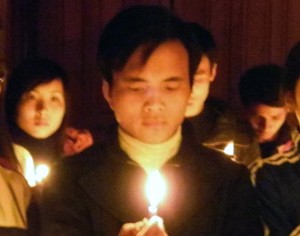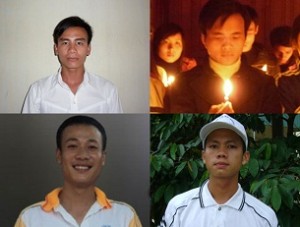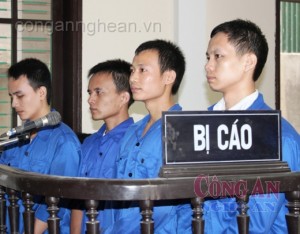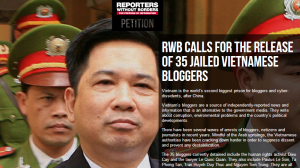The bishop and clergy of the Diocese of Vinh have been battling to assist fishing communities in Ky Anh province who lost their work because of an ecological disaster caused by the Taiwanese-owned Formosa steel mill.
La Croix International, January 9, 2017
A forbidding 10 km long brick wall, topped with barbed wire and punctuated with observation towers, runs along the coast in Ky Anh district in northern Vietnam.
The wall sheltered from view the Formosa Ha Tinh Steel Corporation, an immense iron and steel complex, which has been constructed since 2009 by the Taiwanese Formosa group.
“No access is allowed,” laments Fr Pierre Tran Dinh Lai, parish priest of a new neighborhood in Ky Anh, now home to more than 5,000 fishing families whose lands were appropriated by Formosa.
Fr Lai is one of the first people who was alerted by the fisherfolk of his parish to a maritime pollution event on April 6, 2016, which occurred during the first test runs of the Formosa steelworks.
In the following days, hundreds of thousands of fish were found dead. This maritime disaster was not just confined to the sea and beaches of a 250 km coastline, but also affected numerous fish farms that dot this region in central Vietnam.
“We don’t know what kind of chemical substances were ejected into the sea,” Fr Lai says. “But we know that a diver, who was sent to check the pipes linking Formosa to the sea, died almost instantly.” No samples have yet been taken and no chemical analysis has been authorized by the Vietnamese government since April 6.At this stage people, therefore, have to form their own hypotheses over the scale of the disaster.
“Without a doubt, it involved heavy metals and phenols which should never have been discharged into the sea,” says Bishop Paul Nguyen Thai Hop of Vinh.
Hop himself learned of the disaster on April 20 following the publication on Facebook of a courageous article that has since been taken down.
“I went to the site soon after and the local priests confirmed the facts to me,” Hop says.
On April 27, the Vinh Diocese Commission for Justice and Peace issued its first letter calling for the establishment of an international commission of experts. It also asked for a temporary stop to the steelworks’ operations, as well as a prohibition on the sale of products harvested from the toxic seawater.
On May 13, in a second open letter followed. In it, Bishop Hop, who is also president of the Justice and Peace Commission of the Vietnamese Bishops Conference, estimated the number of people who have been without resources for the past nine months at two million. “These include fisherfolk as well as sellers of fish and shellfish, salt producers, owners of fish ponds, restaurant and hotel owners…Luckily, some families have children in Saigon or overseas who send them money,” he said.
The diocese also now finances the education of young people from the area whose families now have no money.
The environmental consequences are also tragic.
“It will take decades for the ecosystem to be restored,” Bishop Hop predicted.
Heavy metal contamination has severe detrimental effects on human health because marine fauna and flora concentrate deadly poisons.
According to Hop and Fr Lai, around twenty residents of the area around Ky Anh have already died after consuming fish or shellfish from the contaminated zone. However, they are not able to supply precise figures.
“But it is impossible to get access to the medical dossiers of the deceased in the five provinces concerned. And blood analyses of these persons are also prohibited,” the bishop says.
In May, Assumptionist priest, Pierre Tran Van Khuê, parish priest of Phan Thon and hospital chaplain in Vinh, was called to give the sacrament of the sick urgently to “a man suffering indigestion, covered in spots”.
“He had eaten a lobster fished the evening before near Ky Anh. He died soon after,” Fr Khuê said.
Khuê was all the more upset because “the authorities and the media are lying. They insist that there is no longer any danger and that one can now eat seafood again”.
Given the lack of response from the government, the Vinh Diocese invited a Taiwan parliamentary commission to visit the site. In August, the latter arrived at Ky Anh and met with the priests. At the invitation of this parliamentary delegation, a Vinh priest addressed the Taiwan Parliament in December to expose the situation.
“Taiwanese politicians are all the more ready to help us,” the bishop says. “The president is very concerned about Taiwan’s international image and Formosa has already created pollution problems in the past.”
Height Insoles: Hi, I do believe this is an excellent site. I stumbledupon …
http://fishinglovers.net: Appreciate you sharing, great post.Thanks Again. Keep writi…
Achilles Pain causes: Every weekend i used to pay a quick visit this site, as i w…






January 10, 2017
Vietnamese Church stands up for pollution victims
by Nhan Quyen • [Human Rights]
The bishop and clergy of the Diocese of Vinh have been battling to assist fishing communities in Ky Anh province who lost their work because of an ecological disaster caused by the Taiwanese-owned Formosa steel mill.
La Croix International, January 9, 2017
A forbidding 10 km long brick wall, topped with barbed wire and punctuated with observation towers, runs along the coast in Ky Anh district in northern Vietnam.
The wall sheltered from view the Formosa Ha Tinh Steel Corporation, an immense iron and steel complex, which has been constructed since 2009 by the Taiwanese Formosa group.
“No access is allowed,” laments Fr Pierre Tran Dinh Lai, parish priest of a new neighborhood in Ky Anh, now home to more than 5,000 fishing families whose lands were appropriated by Formosa.
Fr Lai is one of the first people who was alerted by the fisherfolk of his parish to a maritime pollution event on April 6, 2016, which occurred during the first test runs of the Formosa steelworks.
In the following days, hundreds of thousands of fish were found dead. This maritime disaster was not just confined to the sea and beaches of a 250 km coastline, but also affected numerous fish farms that dot this region in central Vietnam.
“We don’t know what kind of chemical substances were ejected into the sea,” Fr Lai says. “But we know that a diver, who was sent to check the pipes linking Formosa to the sea, died almost instantly.” No samples have yet been taken and no chemical analysis has been authorized by the Vietnamese government since April 6.At this stage people, therefore, have to form their own hypotheses over the scale of the disaster.
“Without a doubt, it involved heavy metals and phenols which should never have been discharged into the sea,” says Bishop Paul Nguyen Thai Hop of Vinh.
Hop himself learned of the disaster on April 20 following the publication on Facebook of a courageous article that has since been taken down.
“I went to the site soon after and the local priests confirmed the facts to me,” Hop says.
On April 27, the Vinh Diocese Commission for Justice and Peace issued its first letter calling for the establishment of an international commission of experts. It also asked for a temporary stop to the steelworks’ operations, as well as a prohibition on the sale of products harvested from the toxic seawater.
On May 13, in a second open letter followed. In it, Bishop Hop, who is also president of the Justice and Peace Commission of the Vietnamese Bishops Conference, estimated the number of people who have been without resources for the past nine months at two million. “These include fisherfolk as well as sellers of fish and shellfish, salt producers, owners of fish ponds, restaurant and hotel owners…Luckily, some families have children in Saigon or overseas who send them money,” he said.
The diocese also now finances the education of young people from the area whose families now have no money.
The environmental consequences are also tragic.
“It will take decades for the ecosystem to be restored,” Bishop Hop predicted.
Heavy metal contamination has severe detrimental effects on human health because marine fauna and flora concentrate deadly poisons.
According to Hop and Fr Lai, around twenty residents of the area around Ky Anh have already died after consuming fish or shellfish from the contaminated zone. However, they are not able to supply precise figures.
“But it is impossible to get access to the medical dossiers of the deceased in the five provinces concerned. And blood analyses of these persons are also prohibited,” the bishop says.
In May, Assumptionist priest, Pierre Tran Van Khuê, parish priest of Phan Thon and hospital chaplain in Vinh, was called to give the sacrament of the sick urgently to “a man suffering indigestion, covered in spots”.
“He had eaten a lobster fished the evening before near Ky Anh. He died soon after,” Fr Khuê said.
Khuê was all the more upset because “the authorities and the media are lying. They insist that there is no longer any danger and that one can now eat seafood again”.
Given the lack of response from the government, the Vinh Diocese invited a Taiwan parliamentary commission to visit the site. In August, the latter arrived at Ky Anh and met with the priests. At the invitation of this parliamentary delegation, a Vinh priest addressed the Taiwan Parliament in December to expose the situation.
“Taiwanese politicians are all the more ready to help us,” the bishop says. “The president is very concerned about Taiwan’s international image and Formosa has already created pollution problems in the past.”